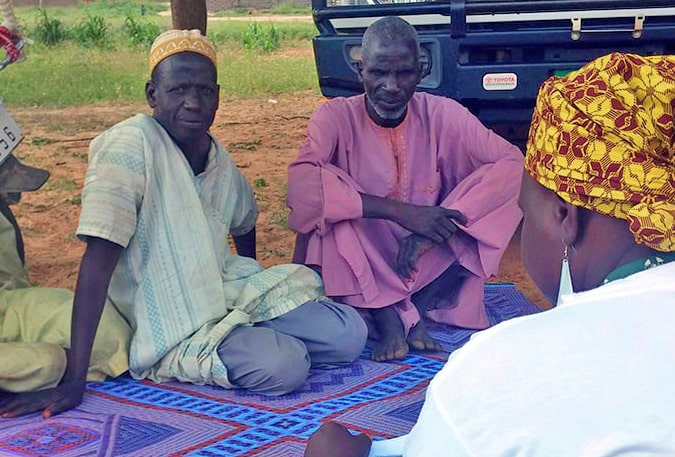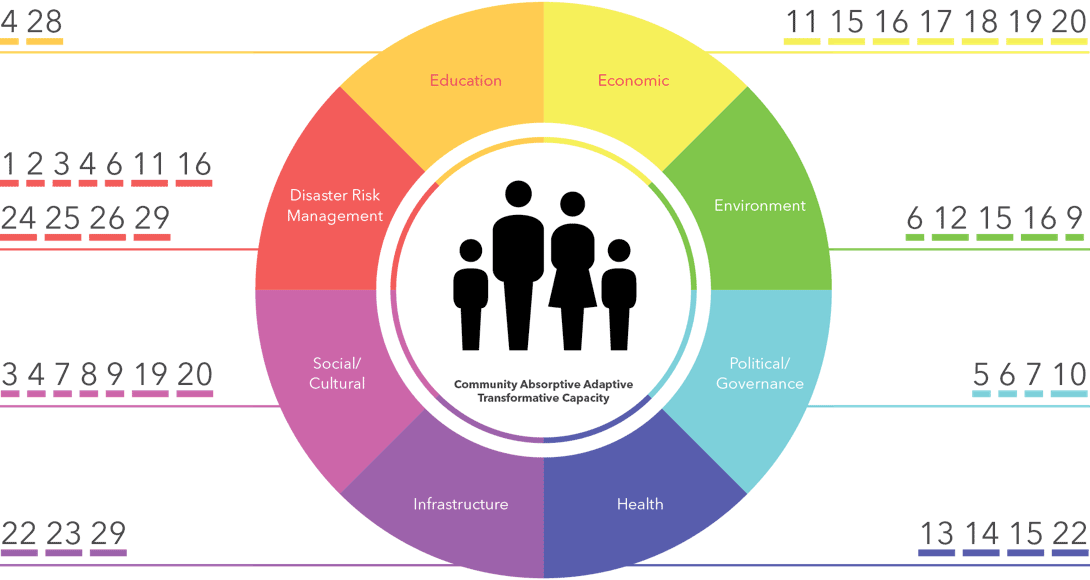What does the ARC-D consist of?
The ARC-D consists of three sections: a two-part disaster resilience survey, accompanied by a user guidance manual and software.
How is disaster resilience measured?
The ARC-D toolkit is used to determine the level of a community’s disaster resilience, in two parts:
Part A assesses the general context of the community, capturing local population data, governance structures, built environment and ecosystem attributes, vulnerable groups, and major risk scenarios.
Part B assesses the community’s disaster resilience level to a chosen risk scenario through a consensus-based focus group discussion, guided by 30 key questions, each linked to a particular resilience component.
The 30 components are categorised into four thematic areas, in line with the 2015-30 Sendai Framework for DRR:

- Understanding disaster risk
- Strengthening governance to manage disaster risk
- Reducing disaster vulnerability for resilience
- Enhancing disaster preparedness for effective response and to “Build Back Better” in recovery
They are also framed along 8 key systems:
Education, Health, Economic, Environmental, Infrastructure, Political / Governance, Social / Cultural, and Disaster Risk Management System
Disaster Risk Management System

Resiliance Analysis
Each question has 5 possible characteristics that indicate a level of resilience for that component, with 1 indicating a weak resilience characteristic (assigned 1 point) and 5 indicating a strong resilience characteristic (assigned 5 points).
The chosen characteristic is substantiated by the documented community answers and verified through specific means during the field assessment. At the end of the assessment process an indicative resilience score is assigned, indicating the community’s resilience level, as per the following table, adapted from Twigg, 2009 and UNISDR, 2012:
|
||||
|
||||
|
||||
|
||||
|
||||
|
Digital Data Gathering
The ARC-D uses a mobile-based application connected to an opensource data collection platform called CommCare. The CommCare mobile app runs on any mobile device with an Android operating system and can work offline. Upon completion of the survey, the app displays the community’s total resilience score, before sending the full assessment results to the CommCare server once connected to the Internet, via wi-fi or mobile data. These data can be exported for analysis to Excel and other files and/or to the Excel dashboard developed by GOAL, which allows for community resilience monitoring in almost real-time as data is collected and submitted from the field. This dashboard generates pro-forma reports consisting of graphs and tables that compare resilience scores over several assessments in one community, among various communities and for various risk scenarios. These simple and informative visuals can be readily understood and shared with key stakeholders involved in community disaster resilience building.
Resilience Radar
“Resilience is the capacity that ensures adverse stressors and shocks do not have long-lasting adverse development consequences.”Mark A. Constas, 2013
Guidance Manual
The guidance manual provides users with a detailed description of the toolkit, containing the justification and background to its development and an explanation of the methodology for applying it in the field and analysing the findings.
“There is compelling evidence that resilience, risk management and early action saves lives and livelihoods.”Christos Stylianides, 2015
EU Commissioner for Humanitarian Aid and Crisis Management
Utility of the ARC-D
While it does not aim to replace existing in-depth assessment tools for community capacities and vulnerabilities, the ARC-D uniquely provides a holistic snapshot of a community’s disaster resilience status, obtained through a rapid assessment that empowers both communities and field staff to understand and operationalise resilience. This snapshot can be used to guide strategy, programming, and advocacy efforts, and, where appropriate, to orient more detailed follow-up assessments.
Benefits of this tool
- It is a practical way to measure disaster resilience at the community level.
- Directs the actions that are necessary to increase the disaster resilience of a community.
- Informs systems approach to disaster resilience building.
- Enables comparisons of the change of community disaster resilience over time.
- It is flexible and adaptable and can be applied in rural, urban and peri-urban contexts, in both development and emergency situations.
- Increases capacity of both communities and field staff in understanding resilience and taking actions to improve it.
- Minimal resources for implementation are required.
“A community is resilient when it can function and sustain critical systems under stress; adapt to changes in the physical, social, and economic environment; and be self-reliant if external resources are limited or cut off.”USAID, 2015
